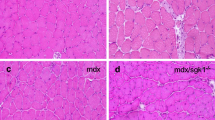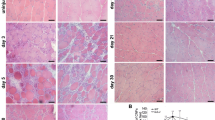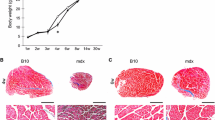Abstract
Laminin α2 (merosin)-deficient congenital muscular dystrophy (CMD) patients show progressive muscle fiber necrosis and ineffective muscle regeneration. This is probably due to decreased formation of multi nucleated myotubes resulting from a myoblast fusion defect. When receiving a mechanical signal from muscle membranes, a cascade of RhoA, focal adhesion kinase (FAK), and serum response factor (SRF) positively regulates myogenesis and muscle hypertrophy associated with functional overload. In contrast, myostatin, a potent negative regulator of skeletal muscle hypertrophy, appears to be up-regulated in the muscles of mdx mice, an animal model for Duchenne muscular dystrophy. Using Western blot and immunohistochemical analyses, we investigated the levels of RhoA, FAK, SRF, and myostatin in the skeletal muscles of dy mice. The amount of RhoA protein was increased in the hindlimb muscles of dy mice aged 12 weeks. At 12 weeks, FAK immunoreactivity was observed in the myonuclei and/or satellite cells of normal mice, but not of dy mice. SRF protein levels decreased markedly in the gastrocnemius and rectus femoris muscles of dy mice at 2 and 12 weeks. Several muscle fibers in normal mice possessed uniform SRF immunoreactivity in the cytoplasm. An SRF immunostaining pattern in muscle was not detected in dy mice. Western blot and the densitometric analysis showed a decreased amount of myocyte enhancer factor 2C (MEF2C) in hindlimb muscles of dy mice. Although slight myostatin immunoreactivity was observed in the nuclei of some normal mice, marked myostatin immunoreactivity was observed in the cytoplasm of mature dy mice myonuclei and/or satellite cells. A low expression of FAK, SRF and MEF2C in muscles of dy mice may inhibit postnatal muscle hypertrophy by fusing satellite cells with existing fibers. Enhancing myostatin protein would result in further atrophy and degeneration of muscle fiber in dy mice.






Similar content being viewed by others
References
Bogdanovich S, Krag TOB, Barton ER, Morris LD, Whittemore L-A, Ahima RS, Khurana TS (2002) Functional improvement of dystrophic muscle by myostatin blockade. Nature 420:418–421
Caro PA, Scavina M, Hoffman E, Pegoraro E, Marks HG (1999) MR imaging findings in children with merosin-deficient congenital muscular dystrophy. Am J Neuroradiol 20:324–326
Carson JA, Wei L (2000) Integrin signaling’s potential for mediating gene expression in hypertrophying skeletal muscle. J Appl Physiol 88:337–343
Catala F, Wanner R, Barton P, Cohen A, Wright W, Buckingham M (1995) Skeletal muscle-specific enhancer regulated by factor binding to E and CArG boxes is present in the promoter of the mouse myosin light chain 1A gene. Mol Cell Biol 14:4585–4596
Flück M, Carson JA, Gordon SE, Ziemiecki A, Booth FW (1999) Focal adhesion proteins FAK and paxillin increase in hypertrophied skeletal muscle. Am J Physiol 277:C152–C162
Flück M, Carson JA, Schwartz RJ, Booth FW (1999) SRF protein is upregulated during stretch-induced hypertrophy of rooster ALD muscle. J Appl Physiol 86:1793–1799
Giancotti FG, Ruoslahti E (1999) Integrin signaling. Science 285:1028–1032
Gordon SE, Flück M, Booth FW (2001) Skeletal muscle focal adhesion kinase, paxillin, and serum response factor are loading dependent. J Appl Physiol 90:1174–1183
Hodges BL, Hayshi YK, Nonaka I, Wang W, Arahata K, Kaufman SJ (1997) Altered expression of the α7β1 integrin in human and murine muscular dystrophies. J Cell Sci 110:2873–2881
Laemmli UK (1970) Cleavage of structural proteins during the assembly of the head of bacteriophage T4. Nature 227:680–685
Langley B, Thomas M, Bishop A, Sharma M, Gilmour S, Kambadur R (2002) Myostatin inhibits myoblast differentiation by down-regulating MyoD expression. J Biol Chem 277:49831–49840
Li L, Liu Z-C, Mercer B, Overbeek P, Olson EN (1997) Evidence for serum response factor-mediated regulatory networks governing SM22α transcription in smooth, skeletal, and cardiac muscle cells. Dev Biol 187:311–321
McPherron AC, Lee S-J (2002) Suppression of body fat accumulation in myostatin-deficient mice. J Clin Invest 109:595-601
Rebello T, Watts DC (1985) Gastrocnemius muscle lipids in relation to diet in two mouse mutants, 129Re-dy and A2G-adr, with abnormal muscle function. J Neurochem 45:257–267
Relan NK, Yang Y, Beqaj S, Miner JH, Schuger L (1999) Cell elongation induces laminin α2 chain expression in mouse embryonic mesenchymal cells: role in visceral myogenesis. J Cell Biol 147:1341–1350
Sakuma K, Watanabe K, Sano M, Kitajima S, Sakamoto K, Uramoto I, Totsuka T (2000) The adaptive response of transforming growth factor-β2 and -βRII in the overloaded, regenerating and denervated muscles of rats. Acta Neuropathol 99:177–185
Sakuma K, Watanabe K, Sano M, Uramoto I, Totsuka T (2000) Postnatal profiles of myogenic regulatory factors and the receptors of TGF-β2, LIF and IGF-I in the gastrocnemius and rectus femoris muscles of dy mouse. Acta Neuropathol 99:169–176
Sakuma K, Watanabe K,Sano M, Uramoto I, Totsuka T (2000) Differential adaptation of growth and differentiation factor 8/myostatin, fibroblast growth factor 6 and leukemia inhibitory factor in overloaded, regenerating and denervated rat muscles. Biochim Biophys Acta 1497:77–88
Sakuma K, Watanabe K, Totsuka T, Sano M, Nakano H, Nakao R, Nishikawa J, Sorimachi, Y, Yoshimoto K, Yasuhara M (2002) The reciprocal change of neurotrophin-4 and glial cell line-derived neurotrophic factor protein in the muscles, spinal cord and cerebellum of the dy mouse. Acta Neuropathol 104:482–492
Sakuma K, Nishikawa J, Nakao R, Nakano H, Sano M, Yasuhara M (2003) Serum response factor plays an important role in the mechanically overloaded plantaris muscle of rats. Histochem Cell Biol 119:149–160
Sastry SK, Lakonishok M, Wu S, Truong TQ, Huttenlocher A, Turner CE, Horwitz AF (1999) Quantitative changes in integrin and focal adhesion signaling regulate myoblast cell cycle withdrawal. J Cell Biol 144:1295–1309
Schultz E (1996) Satellite cell proliferative compartments in growing skeletal muscles. Dev Biol 175:84–94
Sorkin LM, Maley MA, Moch H, Mark H von der, Mark K von der, Cadalbert L, Karosi S, Davies MJ, McGeachie JK, Grounds MD (2000) Laminin alpha4 and integrin alpha6 are upregulated in regenerating dy/dy skeletal muscle: comparative expression of laminin and integrin isoforms in muscles regenerating after crush injury. Exp Cell Res 256:500–514
Srivastava US, Goswami T (1988) Biochemical changes in progressive muscular dystrophy. XV. Distribution of radioactive glutamate and proximate composition of various components of skeletal muscle fiber and liver in vitamin E-deficient dystrophic rabbits and 129/ReJ (dy/dy) mice. Exp Biol 47:185–193
Takano H, Komuro I, Oka T, Shiojima I, Hiroi Y, Mizuno T, Yazaki Y (1998) The Rho family G proteins play a critical role in muscle differentiation. Mol Cell Biol 18:1580–1589
Talim B, Ferreiro A, Cormand B, Vignier N, Oto A, Gogus S, Cila A, Lehesjoki AE, Pihko H, Guicheney P, Topaloglu H (2000) Merosin-deficient congenital muscular dystrophy with mental retardation and cerebellar cysts unlinked to the LAMA2, FCMD and MEB loci. Neuromuscul Disord 10:548–552
Tamaki T, Akatsuka A, Yoshimura S, Roy RR, Edgerton VR (2002) New fiber formation in the interstitial spaces of rat skeletal muscle during postnatal growth. J Histochem Cytochem 50:1097–1111
Thomas M, Langley B, Berry C, Sharma M, Kirk S, Bass J, Kambadur R (2000) Myostatin, a negative regulator of muscle growth, functions by inhibiting myoblast proliferation. J Biol Chem 275:40235–40243
Vachon PH, Xu H, Liu L, Loeche F, Hayashi Y, Arahata K, Reed JC, Wewer UM, Engvall E (1997) Integrins (α7β1) in muscle function and survival. Disrupted expression in merosin-deficient congenital muscular dystrophy. J Clin Invest 100:1870–1881
Wehling M, Cai B, Tidball JG (2000) Modulation of myostatin expression during modified muscle use. FASEB J 14:103–110
Wei L, Zhou W, Croissant JD, Johansen FE, Prywes R, Balasubramanyam A, Schwartz RJ (1998) RhoA signaling via serum response factor plays an obligatory role in myogenic differentiation. J Biol Chem 237:30287–30294
Wei L, Zhou W, Wang L, Schwartz RJ (2000) β1-Integrin and PI 3- kinase regulate RhoA-dependent activation of skeletal α-actin promoter in myoblasts. Am J Physiol 278:H1736–H1743
Acknowledgements
This work was supported by a research Grant-in-Aid for Young Scientists B (nos. 13780029 and 15700423) from the Ministry of Education, Science, Sports and Culture of Japan.
Author information
Authors and Affiliations
Corresponding author
Rights and permissions
About this article
Cite this article
Sakuma, K., Nakao, R., Inashima, S. et al. Marked reduction of focal adhesion kinase, serum response factor and myocyte enhancer factor 2C, but increase in RhoA and myostatin in the hindlimb dy mouse muscles. Acta Neuropathol 108, 241–249 (2004). https://doi.org/10.1007/s00401-004-0884-5
Received:
Revised:
Accepted:
Published:
Issue Date:
DOI: https://doi.org/10.1007/s00401-004-0884-5




